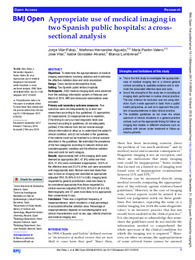Título :
Appropriate use of medical imaging in
two Spanish public hospitals: a crosssectional
analysis |
Autor :
Vilar Palop, Jorge 
Hernández-Aguado, Ildefonso 
Pastor-Valero, Maria 
Vilar, José
González-Alvarez, Isabel
Lumbreras, Blanca  |
Editor :
BMJ Publishing Group [Commercial Publisher] |
Departamento:
Departamentos de la UMH::Salud Pública, Historia de la Ciencia y Ginecología |
Fecha de publicación:
2018-03 |
URI :
https://hdl.handle.net/11000/30537 |
Resumen :
Objectives To determine the appropriateness of medical
imaging examinations involving radiation and to estimate
the effective radiation dose and costs associated.
Design Cross-sectional retrospective study.
Setting Two Spanish public tertiary hospitals.
Participants 2022 medical imaging tests were extracted
from the radiology information system in February and
March of 2014. MRI and ultrasound examinations were
excluded.
Primary and secondary outcome measures Five
outcomes were set independently by at least two
researchers according to four guidelines: (1) appropriate;
(2) inappropriate; (3) inappropriate due to repetition,
if the timing to carry out next diagnostic tests was
incorrect according to guidelines; (4) not adequately
justified, if the referral form did not include enough
clinical information to allow us to understand the patient’s
clinical condition; and (5) not included in the guidelines,
if the referral could not be matched to a clinical scenario
described in the guidelines. We estimated the prevalence
of the five categories according to relevant clinical and
sociodemographic variables and the effective radiation
dose and costs for each category.
Results Approximately half of the imaging tests were
deemed as appropriate (967, 47.8%) while one-third
(634, 31.4%) were considered inappropriate. 19.6% of
the effective dose and 25.2% of the cost were associated
with inappropriate tests. Women were less likely than
men to have an imaging test classified as appropriate
(adjusted OR 0.70,95% CI 0.57 to 0.86). Imaging tests
requested by general practitioners were less likely to
be considered appropriate than those requested by
central services (adjusted OR 0.60, 95% CI 0.38 to 0.93).
Mammography and CT were more likely to be appropriate
than conventional X-rays.
Conclusion There was a significant frequency of
inappropriateness, which resulted in a high percentage
of associated effective radiation dose. Percentage of
inappropriateness depends on sociodemographic and
clinical characteristics such as sex, age, referral physician and medical imaging test.
|
Palabras clave/Materias:
radiation exposure
imaging test
appropriateness
evidence guidelines
justification |
Área de conocimiento :
CDU: Ciencias aplicadas: Medicina |
Tipo de documento :
info:eu-repo/semantics/article |
Derechos de acceso:
info:eu-repo/semantics/openAccess
Attribution-NonCommercial-NoDerivatives 4.0 Internacional |
DOI :
https://doi.org/10.1136/bmjopen-2017-019535 |
Publicado en:
BMJ Open. 2018; 8(3) |
Aparece en las colecciones:
Artículos Salud Pública, Historia de la Ciencia y Ginecología
|
 La licencia se describe como: Atribución-NonComercial-NoDerivada 4.0 Internacional.
La licencia se describe como: Atribución-NonComercial-NoDerivada 4.0 Internacional.
.png)
